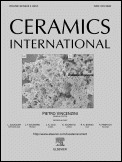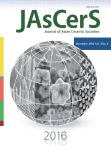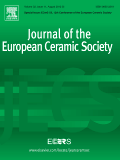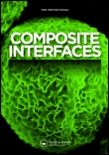
Ceramics International
Scope & Guideline
Elevating the standards of ceramics research worldwide.
Introduction
Aims and Scopes
- Synthesis and Processing Techniques:
The journal covers novel methods for synthesizing ceramic materials, including sol-gel processes, combustion synthesis, and additive manufacturing techniques. - Characterization of Ceramics:
Research articles often focus on the structural, mechanical, thermal, and electrical characterization of ceramics, employing advanced analytical techniques such as X-ray diffraction, electron microscopy, and spectroscopy. - Properties and Applications:
The journal emphasizes the exploration of the properties of ceramic materials, including their dielectric, magnetic, optical, and mechanical properties, and their applications in fields such as electronics, catalysis, and biomaterials. - Environmental and Sustainable Materials:
There is a significant focus on the development of environmentally friendly and sustainable ceramic materials, including the recycling of industrial waste and the use of bio-based materials. - Advanced Functional Ceramics:
The journal includes studies on functional ceramics that exhibit unique properties for specific applications, such as piezoelectric, ferroelectric, and thermoelectric ceramics.
Trending and Emerging
- Nano-Structured and Hybrid Ceramics:
There is an increasing focus on the synthesis and application of nano-structured ceramics and hybrid materials, which exhibit enhanced properties for various applications, including energy storage and catalysis. - Electrochemical and Energy Applications:
Research related to ceramic materials for energy applications, such as solid oxide fuel cells (SOFCs), batteries, and supercapacitors, is trending, emphasizing the need for efficient and durable materials. - Sustainable and Green Ceramics:
The development of sustainable ceramic materials, including those derived from waste and environmentally friendly processes, is becoming a prominent theme as industries seek to reduce their environmental impact. - Functional Coatings and Surface Engineering:
Emerging research in functional coatings and surface modifications for ceramics highlights the need for enhanced properties such as wear resistance, corrosion protection, and catalytic activity. - Biomedical Applications of Ceramics:
There is a growing interest in the application of ceramics for biomedical uses, particularly in drug delivery systems, tissue engineering scaffolds, and bioactive materials.
Declining or Waning
- Traditional Ceramic Materials:
Research on conventional ceramics, such as traditional pottery and basic porcelain, appears to be declining as the focus shifts towards advanced functional ceramics and innovative materials. - Basic Phase Diagrams and Crystal Growth:
There is a reduced emphasis on fundamental studies related to phase diagrams and crystal growth mechanisms, as more applied and technology-driven research takes precedence. - Low-Temperature Sintering Techniques:
Research specifically focused on low-temperature sintering methods for traditional ceramics seems to be waning, possibly due to the growing interest in high-performance materials that require advanced processing techniques.
Similar Journals

Korean Journal of Materials Research
Shaping the Future of Materials ApplicationsKorean Journal of Materials Research is a pivotal publication in the field of materials science, offering a platform for innovative research and comprehensive reviews in miscellaneous materials applications. Published by the MATERIALS RESEARCH SOC KOREA, this journal has been a valuable resource since its inception in 2007 and continues to disseminate vital findings through 2024. Although currently categorized in Q4 of the Materials Science quartiles, the journal is committed to advancing knowledge and fostering research collaboration within the scientific community. With an ISSN of 1225-0562 and an E-ISSN of 2287-7258, the journal aims to bridge gaps in research and practice, appealing to a diverse audience of researchers, professionals, and students interested in the latest advancements in materials science. While access to content may not be open, the journal's impact in the regional and global research landscape is steadily growing, as indicated by its Scopus ranking in the 7th percentile of General Materials Science. Engage with the Korean Journal of Materials Research to stay at the forefront of materials innovation!

Journal of Asian Ceramic Societies
Fostering collaboration in ceramic advancements.The Journal of Asian Ceramic Societies, published by Taylor & Francis Ltd, is a peer-reviewed open-access journal that has been at the forefront of ceramic research since its inception in 2013. With an ISSN of 2187-0764, this esteemed journal is dedicated to advancing the scientific understanding of ceramics and composites, bolstered by an impressive ranking of Q2 in the field of Materials Science. Covering a wide range of topics pertinent to ceramics, the journal aims to foster collaboration among researchers, professionals, and students across Asia and beyond. Its commitment to accessibility allows a global audience to engage with cutting-edge research, reflected in its Scopus ranking of #45 out of 127 in the Materials Science category. With a publication timeline extending to 2024, the Journal of Asian Ceramic Societies is an indispensable resource for anyone looking to stay informed on the latest developments and innovations in ceramic technology.

Journal of the European Ceramic Society
Advancing the Frontiers of Ceramic InnovationThe Journal of the European Ceramic Society, published by Elsevier, is a premier academic periodical dedicated to the cutting-edge advancements in the fields of ceramics and composites, as well as materials chemistry. With an impressive impact factor that places it in the top quartile (Q1) of its category, it ranks #33 out of 317 in Materials Science and #16 out of 127 in Ceramics and Composites, showcasing its strong influence in the scientific community. Established in 1989 and set to converge until 2025, this journal serves as a critical platform for researchers and professionals to disseminate their findings, share ideas, and foster collaboration in the rapidly evolving area of ceramic materials. Although it does not offer Open Access options, the journal ensures rigorous peer review and maintains high standards for publication, making it an essential resource for students, academics, and industry experts who are pushing the boundaries of material science.

JOURNAL OF SOL-GEL SCIENCE AND TECHNOLOGY
Bridging Theory and Application in Sol-Gel ScienceJOURNAL OF SOL-GEL SCIENCE AND TECHNOLOGY, published by Springer, is a vital resource within the interdisciplinary fields of materials science and engineering, focusing on innovative research related to sol-gel processes and applications. With a rich publication history spanning from 1993, this journal enables the dissemination of cutting-edge findings in biomaterials, ceramics, and composites, ranking impressively across various categories—Q3 in Biomaterials and Q2 in several other materials-related fields. The journal's commitment to quality research is reflected in its Scopus rankings, particularly notable in the categories of Condensed Matter Physics and Materials Chemistry. Researchers and professionals leveraging the insights from this journal are supported through its comprehensive scope, which bridges theoretical foundations with practical applications, advancing knowledge and fostering collaboration among academics and industry leaders alike. As a non-open access journal, it is essential for subscribers and institutions to engage deeply with the latest advancements documented within its pages, underscoring the journal's role in shaping the future of sol-gel science and technology.

COMPOSITE INTERFACES
Pioneering Research in Composites and CeramicsComposite Interfaces is a prominent journal dedicated to advancing the scientific understanding and applications of composite materials and interfaces, published by Taylor & Francis Ltd. Since its inception in 1993, this journal has become a pivotal resource for researchers and practitioners in the fields of ceramics and composites, as well as in physics and materials sciences. With a commendable Q2 ranking in 2023 across multiple categories, including Ceramics and Composites, Physics and Astronomy, and Surfaces, Coatings and Films, Composite Interfaces ensures a high standard of scholarly excellence, reflected in its robust Scopus rankings. While the journal operates under a subscription model, its influential body of work is vital for those seeking to innovate in composite material applications. By fostering scholarly communication, Composite Interfaces plays a crucial role in the progression of material science, an area of increasing relevance in technology and engineering.

Journal of Ceramic Science and Technology
Transforming Research into Real-World ApplicationsJournal of Ceramic Science and Technology, published by GOLLER VERLAG GMBH in Germany, serves as a vital platform for advancements in the field of ceramics and composites. Since its inception in 2010, the journal has contributed significantly to the scholarly literature, encompassing a wide range of topics including the development of new ceramic materials, nanocomposites, and their various applications in industries such as electronics, energy, and medicine. Although currently categorized in the Q4 quartile of ceramics and composites and ranked within the lower percentile in Scopus, the journal strives to bridge the gap between fundamental research and practical implementation, fostering innovative solutions to contemporary materials challenges. With an open-access format, it ensures that valuable findings are disseminated widely, promoting collaboration and knowledge sharing among researchers, professionals, and students in the field. As it converges towards 2024, the Journal of Ceramic Science and Technology remains committed to enhancing the understanding and utilization of ceramic materials, making it an indispensable resource for those dedicated to advancing this dynamic area of study.

Journal of the Korean Ceramic Society
Leading the way in ceramic materials research and discovery.The Journal of the Korean Ceramic Society is a premier academic journal dedicated to advancing the field of ceramics and composites, serving as a vital platform for researchers, professionals, and students alike. Published by SPRINGER HEIDELBERG, this journal boasts an impressive scopus rank of #49 out of 127 in the Materials Science category, with a commendable 61st percentile ranking, highlighting its impact and relevance in contemporary research. Since its inception, the journal has been converging significant research contributions from 2007 to 2024, consistently fostering innovation in ceramic materials and their diverse applications. Although it operates under a traditional access model, the journal remains committed to disseminating high-quality research in ceramics and composites, currently positioned in the Q2 category for 2023. With a strategic focus on the latest developments, methodologies, and interdisciplinary approaches, the Journal of the Korean Ceramic Society is essential reading for anyone engaged in materials science and engineering, aiming to navigate the complexities of this dynamic field.

JOURNAL OF INORGANIC MATERIALS
Exploring the Depths of Inorganic ChemistryJOURNAL OF INORGANIC MATERIALS, published by SCIENCE PRESS, is a prominent platform dedicated to the dissemination of research in the fields of inorganic chemistry and materials science. With a history spanning over three decades since its inception in 1993, this journal has become a key resource for academics and industry professionals alike, aiming to advance the understanding of inorganic materials through rigorous research findings. It operates under a strict peer-review process, ensuring high-quality contributions that uphold its reputation within the scientific community. Currently ranking in the Q3 category for both inorganic chemistry and miscellaneous materials science, the journal holds a significant position in Scopus rankings, further solidifying its relevance and impact. Researchers will find this journal an essential avenue for the latest discoveries and methodologies in inorganic materials, fostering innovation and collaboration in a vital area of science.

Advanced Powder Materials
Advancing the Future of Materials ScienceAdvanced Powder Materials, published by KEAI PUBLISHING LTD, stands at the forefront of research in materials science, particularly focusing on the intricate relationships within powder materials and their applications across several domains including catalysis, ceramics, energy, and coatings. With an Open Access policy initiated in 2022, this journal ensures that cutting-edge findings are readily accessible to researchers, professionals, and students globally. Based in Beijing, China, the journal has gained recognition for its exceptional impact, achieving a prestigious Q1 ranking in multiple categories such as Catalysis, Ceramics and Composites, and Materials Science. The journal not only promotes innovative research but also serves as a vital platform for interdisciplinary collaboration, significantly impacting the fields it covers, which also include notable rankings in Metals and Alloys and Surfaces, Coatings, and Films. By fostering an environment of knowledge sharing, Advanced Powder Materials is poised to make substantial contributions to the scientific community over its converged years from 2022 to 2024.

REFRACTORIES AND INDUSTRIAL CERAMICS
Advancing the Frontier of Ceramics ResearchREFRACTORIES AND INDUSTRIAL CERAMICS is a prestigious journal published by Springer, dedicated to the field of ceramics and composite materials. With an ISSN of 1083-4877 and an E-ISSN of 1573-9139, this journal plays a pivotal role in fostering advances in the development, formulation, and application of refractories and industrial ceramics. The journal has been actively publishing since 1996 and is recognized for its contribution to the academic discourse in the ceramics community. Although it currently holds a Q4 ranking in both Ceramics and Composites and Materials Chemistry categories, it serves as an important platform for emerging research trends and innovations, making it essential reading for researchers, professionals, and students engaged in material science. While access is not open, the journal ensures that high-quality research reaches its audience, reflects the evolving landscape of the ceramics industry, and encourages interdisciplinary collaboration.